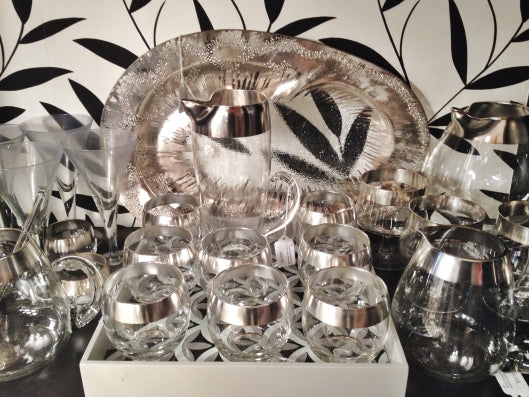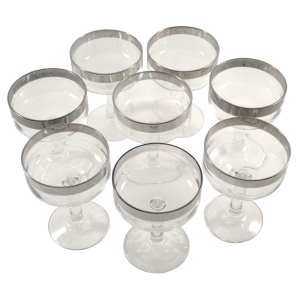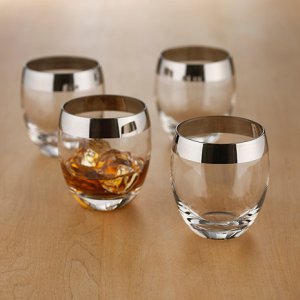
Dorothy Thorpe’s mid century designs are both classic and timeless.
More and more cocktailians appreciate the simple clean style of glassware that Dorothy Thorpe designed. Thorpe’s timeless classic designs continue to draw the interest of these cocktail connoisseurs and vintage glassware buyers. Unfortunately, as the popularity of Thorpe’s mid century glass designs has increased, the misrepresentation of her products has also risen. In the marketplace, Thorpe’s glassware commands premium prices due to her style as well as the techniques and materials she used to produce the glass pieces. But buyer beware. Just because a vintage glassware piece is represented as being designed by “Dorothy Thorpe” on the internet, does not necessarily mean that this is true. When buying vintage glassware, you should trust that what the seller is telling you is correct. Some sellers, often unknowingly, represent an item as being designed by Dorothy Thorpe because they either believe their item looks close enough to something Thorpe designed or because they, in fact, are getting their information from a misrepresentation of something they’ve seen on the internet. I’ll try, once again, to help clarify this matter by showing examples of Thorpe’s work.
As I’ve written before, Dorothy Thorpe was a decorator of glassware not a manufacturer of it. In the beginning of her career, Thorpe’s mid century designs were sandblasted onto blank glassware that she bought from glassware manufacturers. Her original designs were inspired by flora and fauna and included images of eucalyptus, irises, roses and narcissus flowers that were sandblasted onto crystal glass.
#18230, Set of 4 Dorothy Thorpe Cordials
Later, she designed glassware with overlays of wide bands of sterling silver. Her Allegro pattern used high quality sterling silver and had bands that measured close to an inch. The wide banded glassware was produced on cocktail pitchers and decanters as well as a variety of glassware types (i.e., footed cocktail stems, rocks glasses, collins glasses and roly poly glasses). This vintage glass design was popularized by the television show Mad Men during its first two seasons.
#17461, Set of 4 Thorpe Allegro Cocktail Stems
#18469, Thorpe Allegro Cocktail Pitcher
#18286, Set of 8 Thorpe Allegro Roly Poly Glasses
Because of the sterling silver overlay on the edges of this glassware, these glass pieces will tarnish and require delicate cleaning. Overlay pieces that are scratched or have any sterling missing (especially on the rims) command a lower price than mint glassware.
During the atomic age, Thorpe also designed glassware which became known as the Atomic Splash. Typically found on serving pieces of the time, this glassware also uses sterling silver overlay on crystal. As the name implies, the sterling looks as though it has exploded or been splashed all over the glassware.
#9979, Thorpe Atomic Splash Serving Tray
Finally, Thorpe also designed glass pieces that were speckled in nature. Her designs included gold flecks as well as pastel colors speckled onto the glassware.
#17587, Set of 7 Thorpe Gold Fleck Cocktail Stems
As you can tell from the pictures above, Thorpe designed high-end glassware during her time. She sold her pieces at department stores including Neiman Marcus and Gumps. Her glassware was typically signed with a large “T” and a smaller “D” and “C”. This logo was often sandblasted into the base of her stemware pieces. When buying vintage Thorpe glassware, the Thorpe logo also can be found on stickers that marked her pieces at the time.


So what styles of glassware are some vintage glassware sellers misrepresenting to be Dorothy Thorpe designs? Pretty much anything with a silver rim is described as being designed by Dorothy Thorpe. In the 1950s and 1960s, U.S. glass manufacturers produced all sorts of “silver” rim glassware. While the pieces are often described as silver, they are not made with sterling silver. These vintage glasses have a much more “smokey” appearance to the silver color than the Thorpe pieces designed with sterling silver overlays. Often called “mercury” rim as the color was similar to the color of old mercury thermometers used at the time, many of these designs were produced in the U.S. by companies such as Libbey and Queens Lusterware. The glasses typically have smaller bands of silver on the glass rims or are embellished with polka dots or other silver patterns. While still attractive, these silver or mercury rim vintage glass pieces command a lower price than the Dorothy Thorpe sterling silver pieces.
#18004, Set of 8 Mercury Band Coupes
#18151, Mercury Band Cocktail Pitcher Set
#15087, Mercury Band Ice Bucket Set
#16813, Mercury Band Polka Dot Cocktail Caddy
Faded mercury glassware which “bleeds” into the glass is also often attributed to Thorpe but was likely produced by these other glassware companies. Again, you will notice how different the color of the silver is compared to the sterling silver overlay pieces of Thorpe.
#18019, Mercury Fade Cocktail Pitcher Set
#18149, Mercury Fade Collins Caddy
Finally, buyers of vintage Thorpe glassware should be aware that new silver rim Thorpe-inspired glassware is currently being produced, especially in the roly poly shape. While new to the market, this glassware is sometimes misrepresented as being vintage. Again, not only is the silver a different color (as it is not sterling silver), but the shape of the glass is not the classic vintage roly poly shape.
Although Dorothy Thorpe’s style may be copied, to us there is nothing like her original designs on true vintage glassware.
For more, visit us at:













